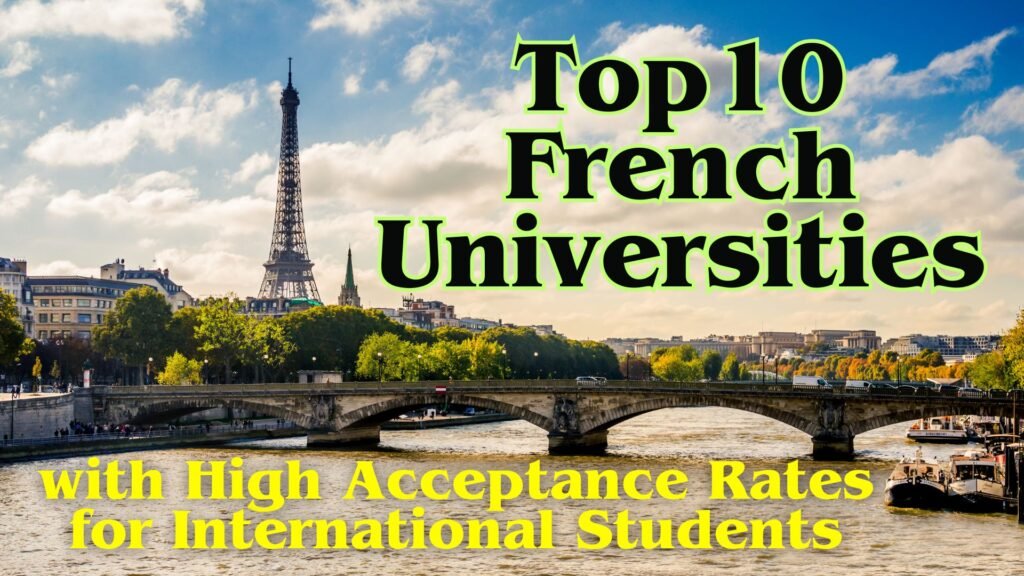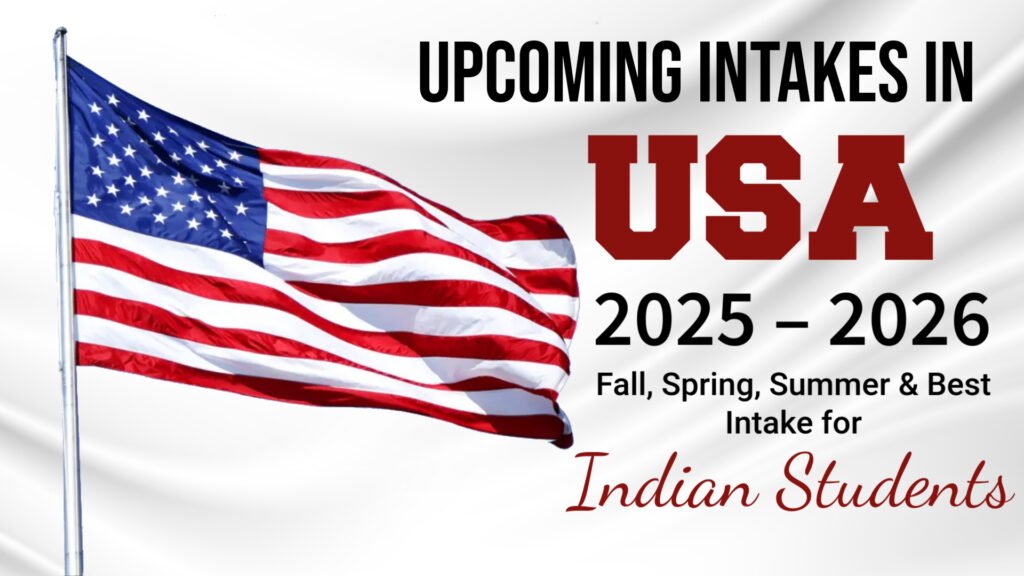Top 10 French Universities with High Acceptance Rates for International Students

Top 10 Universities in France with High Acceptance Rates for International Students France is an increasingly popular destination for international students pursuing higher education. With its world-renowned institutions, vibrant culture, and relatively affordable tuition fees, France has become a preferred study destination. French universities are highly ranked in global academic rankings and offer a wide range of programs across various disciplines. Moreover, France is becoming an attractive option for Indian students, with projections indicating that their numbers will reach 25,000 by 2025. Top Courses at Universities in France French universities attract thousands of international students each year across multiple disciplines. Some of the most sought-after courses in France include: Law Political Science Economics Humanities Social Sciences Mathematics Computer Science Physics and Engineering These programs are available at top-ranked institutions and provide students with a strong academic foundation, research opportunities, and industry exposure. Application Process at Top Universities in France Public universities in France admit international students through Campus France, the country’s official agency for higher education promotion. Private universities, however, have their own application processes, which can be accessed through their respective websites. Steps to Apply: Research and Evaluate: Identify areas of interest and potential universities that offer the desired courses. Explore Universities: Review course details, curriculum, fee structures, scholarship options, and future career opportunities. Application Process (Campus France): Submit applications through the online portal, attend interviews if required, and wait for responses from universities. Receive Acceptance Letter: After completing the two-stage admission process, successful applicants will receive their acceptance letters. Visa Application: Following admission, students must apply for a French student visa to commence their studies. Documents Required for Admission Applicants typically need the following documents when applying to universities in France: High school diploma (for undergraduate programs) Bachelor’s degree certificate (for master’s programs) Master’s degree certificate (for doctoral programs) Passport Student visa Proof of English or French language proficiency (TOEFL, IELTS, or DELF/DALF for French) Intakes at Top Universities in France France offers two primary intakes for international students: Fall Intake: The main intake, commencing in September-October, offers the widest range of programs. Spring Intake: A smaller intake beginning in January, available for select programs. Cost of Living in France While tuition fees in France are relatively affordable compared to other popular study destinations, the cost of living varies by city. Paris, being the capital, has higher living costs, whereas cities like Lyon, Toulouse, and Nantes offer more budget-friendly options. On average, students should budget for accommodation, food, transportation, health insurance, and personal expenses. Universities in France with High Acceptance Rates The following universities in France have relatively high acceptance rates, making them more accessible to international students: The following universities in France have relativa HEC Paris has an acceptance rate of 27% and is ranked 291st in the QS World Rankings. University of Paris has a lower acceptance rate of 17% and holds the 236th position globally. Sciences Po Paris has an 18% acceptance rate and is ranked 319th in the QS World Rankings. Paris Sciences et Lettres (PSL) Research University has a 20% acceptance rate and is ranked 26th worldwide. École Polytechnique has a highly competitive acceptance rate of 9% and is ranked 36th in the world. Frequently Asked Questions (FAQs) 1. What are some of the top universities in France for international students? France has several prestigious universities for international students, including: Paris Sciences & Lettres University (PSL) – QS Rank #24 Institut Polytechnique de Paris – QS Rank #38 Sorbonne University – QS Rank #59 2. Why should international students choose French universities? French universities are known for their academic rigor, innovative research opportunities, and cultural diversity. Many programs are taught in English, and tuition fees are relatively lower compared to other study destinations. Additionally, students can experience a rich cultural and historical environment while pursuing their education. 3. What is the average tuition fee for studying in France? Public universities in France offer affordable education, with fees ranging from €170 to €600 per year for bachelor’s programs and €250 to €1,000 per year for master’s programs. Private universities and business schools may have higher tuition fees. 4. Do I need to speak French to study in France? Not necessarily. Many universities in France offer courses in English, especially at the postgraduate level. However, learning French can be beneficial for daily life and job opportunities in France. 5. How can international students find scholarships in France? Several scholarships are available for international students, including: Eiffel Excellence Scholarship (offered by the French Ministry for Europe and Foreign Affairs) Campus France Scholarships Erasmus+ Scholarships (for EU and non-EU students) University-specific scholarships By carefully researching and applying early, students can secure financial aid to support their studies in France. Studying in France provides a unique academic and cultural experience that prepares students for successful careers globally. With high-quality education, affordable tuition, and welcoming policies for international students, France remains a top choice for higher education.
Best Colleges to Study Masters in Ireland for Indian Students 2025

Best Colleges to Study Masters in Ireland for Indian Students 2025 Why Study at Top Colleges for Masters in Ireland? Ireland has emerged as a top destination for Indian students seeking high-quality education, global exposure, and excellent career opportunities. The country’s universities are well-recognized for their strong academic programs, research initiatives, and strong industry connections. Here’s why studying in Ireland is a great choice: Globally Recognized Universities: Many Irish institutions rank among the world’s best, offering high-quality education and cutting-edge research. Diverse and Inclusive Environment: Ireland is home to a large number of international students, fostering a multicultural and welcoming atmosphere. Post-Study Work Opportunities: Ireland provides a two-year post-study work visa, making it an attractive destination for those looking to gain international work experience. Industry Links & Career Prospects: Strong connections with global companies in technology, finance, and healthcare sectors increase employment opportunities. Affordable Tuition & Scholarships: Compared to other study-abroad destinations, Ireland offers competitive tuition fees and various scholarships for Indian students. Top 10 Masters Colleges in Ireland Below is a list of the top universities in Ireland for master’s programs along with their QS World Rankings for 2025: Trinity College Dublin is ranked 87 in the QS World Rankings for 2025. University College Dublin holds the 126th position globally. University College Cork is ranked 273 in the world. University of Galway shares the 273rd position in the rankings. Dublin City University is placed at 421 globally. University of Limerick also holds a ranking of 421. Maynooth University falls within the 801-850 ranking range. Technological University Dublin is positioned between 851-900 in the rankings. Munster Technological University is currently not ranked. South East Technological University is also not ranked in the QS World Rankings for 2025. Application Deadlines and Tuition Fees Application Deadlines Irish universities generally follow two main intake cycles: Fall Intake (September Start): Applications open from January to July. Spring Intake (January Start): Applications are typically accepted from August to December. Tuition Fees Average tuition fees range from €12,000 to €18,000 per year depending on the university and program. Business and STEM-related programs may have slightly higher fees. Admission Requirements for Masters Programs in Ireland To apply for a master’s degree in Ireland, students must meet the following general requirements: Bachelor’s Degree: A recognized undergraduate degree with a strong academic record. English Language Proficiency: Proof through IELTS (typically a minimum score of 6.5) or TOEFL. Supporting Documents: Transcripts, Letters of Recommendation (LORs), a Statement of Purpose (SOP), and a CV/resume. GRE/GMAT (if required): Some business and technical programs may ask for these scores. Specific requirements vary by university and program, so checking the respective university’s website is recommended. Scholarships for Indian Students in Ireland Several scholarships are available to help Indian students manage their expenses while studying in Ireland: Government of Ireland Scholarships: Covers tuition fees and provides a stipend for outstanding students. University-Specific Scholarships: Trinity College Dublin: Merit-based scholarships for international students. University College Dublin (UCD): The V.V. Giri Scholarship is specifically available for Indian students. University of Galway: Offers a range of scholarships for postgraduate students. Dublin City University: Provides financial aid to high-achieving international students. Tips for Securing Admission to a Master’s Program in Ireland Start Early: Begin researching universities, programs, and scholarship options at least a year before applying. Meet Language Requirements: Prepare for IELTS or TOEFL in advance and aim for a score higher than the minimum requirement. Craft a Strong SOP: Your Statement of Purpose should highlight your academic background, career goals, and why you chose Ireland. Obtain Strong LORs: Request Letters of Recommendation from professors or employers who can vouch for your academic and professional abilities. Apply to Multiple Universities: Increase your chances of admission by applying to a mix of top-ranked and mid-tier universities. Check Program-Specific Requirements: Some courses require work experience or GRE/GMAT scores, so confirm before applying. Apply for Scholarships: Look for financial aid opportunities early and submit well-prepared scholarship applications. Prepare for Visa Application: Ensure you have sufficient funds and all necessary documents ready for a smooth visa process. Career Prospects & Job Opportunities in Ireland Ireland has a thriving job market, especially in the fields of technology, pharmaceuticals, finance, and business. Major global companies like Google, Apple, Facebook, Intel, and Pfizer have their European headquarters in Ireland, providing ample job opportunities for graduates. Post-Study Work Visa: The two-year stay-back option allows students to gain valuable work experience. Growing Industries: IT, Finance, Data Analytics, Healthcare, and Engineering offer high-paying job prospects. Average Salary: Master’s graduates in Ireland can expect salaries ranging from €35,000 to €50,000 per year, depending on the field and experience. Frequently Asked Questions (FAQs) 1. Can I work while studying in Ireland? Yes, international students can work up to 20 hours per week during the academic term and 40 hours per week during holidays. 2. Are there part-time job opportunities for students? Yes, many students work part-time in retail, hospitality, and on-campus jobs to support their living expenses. 3. Do I need a student visa to study in Ireland? Yes, Indian students need a D Study Visa, which requires proof of university admission, financial stability, and English proficiency. 4. Which courses have the best job prospects in Ireland? Courses in Data Science, Business Analytics, Engineering, Computer Science, and Pharmaceuticals offer excellent career prospects. 5. How do I apply for scholarships in Ireland? Scholarships can be applied through university websites or the Government of Ireland Scholarships portal. It is recommended to apply early as funding is limited. Conclusion:- Studying in Ireland is a fantastic opportunity for Indian students looking to gain a world-class education and enhance their career prospects. With numerous top-ranked universities, strong industry links, and excellent post-study work opportunities, Ireland continues to be a preferred destination for higher education. By planning your application early and exploring available scholarships, you can make the most of your educational journey in Ireland.
Upcoming Intakes in USA 2025 – 2026: Fall, Spring, Summer & Best Intake for Indian Students

Upcoming Intakes in USA 2025 – 2026: Fall, Spring, Summer & Best Intake for Indian Students Introduction:- Studying in the United States is a dream for many Indian students seeking world-class education, advanced research opportunities, and global exposure. However, one of the most critical decisions students must make is selecting the right intake. The USA follows a tri-semester academic structure, offering three major intakes: Fall Intake (September – December) Spring Intake (January – May) Summer Intake (May – August) Each intake comes with its own advantages and challenges. Choosing the right one depends on factors like course availability, admission deadlines, financial planning, and career aspirations. This blog provides an in-depth analysis of each intake to help students make an informed decision about their academic journey in the USA. Understanding the Three Intakes in USA 1. Fall Intake in USA 2025 When? September – DecemberApplication Period: November 2024 – May 2025 Most Popular Intake: The majority of universities in the USA offer a wide range of programs during the Fall semester. Better Scholarship Opportunities: Many universities allocate their financial aid and scholarships primarily to students joining in Fall. Internship and Job Prospects: Students have a higher chance of securing summer internships as they complete one academic year before applying. Extensive Networking Opportunities: Large student enrollments lead to a vibrant campus environment with numerous clubs, societies, and networking events. On-Campus Jobs and Assistantships: Many graduate students find better research and teaching assistant opportunities in Fall. 2. Spring Intake in USA 2026 When? January – MayApplication Period: July – December 2025 Second-Chance Entry: Students who missed the Fall intake due to application deadlines, visa issues, or personal reasons can join in Spring. Faster Admission Decisions: Many universities process Spring applications more quickly than Fall. Smaller Class Sizes: The competition is lower compared to Fall, leading to better faculty interaction and personalized learning experiences. Limited Course Options: While many programs are available, some courses may not be offered until Fall, which could extend graduation timelines. Fewer Scholarships: While financial aid is available, it is generally more competitive and limited compared to Fall. 3. Summer Intake in USA 2025 When? May – AugustApplication Period: January – March 2025Why Choose Summer Intake? Short-Term & Specialized Courses: Ideal for students looking to take short-term certifications, language courses, or research projects. Less Competition: Fewer students apply, making it easier to secure admission. Faster Completion: Some students use Summer intake to fast-track their degrees by taking extra courses. Limited Availability: Not all universities participate in the Summer intake, and degree programs are scarce. Key Differences Between USA Intakes Fall Intake: Runs from September to December. The application period is from November to May. A wide range of programs is available during this intake. Spring Intake: Takes place from January to May. The application period is from July to December. Course availability is limited, with fewer options compared to the Fall intake. Summer Intake: Runs from May to August. The application period is from January to March. This intake mainly offers short-term and specialized programs. Which Intake Should Indian Students Choose? Fall Intake: Best for Maximum Opportunities If you are looking for the best academic experience, networking opportunities, and job prospects, Fall is the preferred intake. Scholarships, assistantships, and on-campus jobs are more readily available. Most Indian students opt for this intake. Spring Intake: A Good Alternative If you are unable to apply for the Fall intake due to exams, visa processing, or application delays, Spring is a viable alternative. However, be prepared for limited course offerings and slightly fewer funding options. Summer Intake: Best for Short-Term Goals If you are looking for quick certifications or specialized training, Summer is a good choice. However, if you want a full-time degree program, it is not the ideal intake. When Should You Apply? Applying early increases your chances of securing admission, scholarships, and a smooth visa process. Below are the ideal timelines:- Fall Intake: Applications open from November 2024 – May 2025. Apply early for scholarships. Spring Intake: Applications open from July – December 2025. Ensure visa documentation is ready by October. Summer Intake: Applications open from January – March 2025. Early application is advised as limited universities participate. Common Mistakes to Avoid When Choosing an Intake Missing Application Deadlines: Keep track of university deadlines and submit all documents on time. Not Researching Course Availability: Not all programs are available in every intake. Check the university website before applying. Overlooking Financial Aspects: Tuition fees, living costs, and scholarships vary for different intakes. Plan your finances accordingly. Ignoring Visa Processing Times: Applying late for a visa can lead to unexpected delays. Factor in embassy wait times. Choosing an Intake Without Career Planning: If your goal is internships or early job placements, Fall intake is the best choice. Frequently Asked Questions (FAQs) 1. How many intakes are there in the USA? There are three major intakes: Fall (September), Spring (January), and Summer (May). 2. Which intake is best for Indian students? The Fall intake is the most preferred due to maximum course availability, scholarships, and job opportunities. 3. What are the application deadlines for each intake? Fall: November – May, Spring: July – December, Summer: January – March. 4. Can I apply to multiple intakes? Yes, but each application requires separate documents and fees. Always check program availability. 5. What factors should I consider while choosing an intake? Course availability, scholarship opportunities, job prospects, personal readiness, and visa processing timelines. Conclusion:- Choosing the right intake is crucial for a smooth and successful academic journey in the USA. While Fall remains the most popular choice for Indian students due to its extensive offerings, Spring and Summer intakes provide flexibility for those who miss the Fall deadlines or have specific short-term academic goals. Planning ahead, meeting application deadlines, and researching university requirements will ensure a hassle-free admission process. By carefully evaluating your personal, financial, and academic circumstances, you can select the intake that best aligns with your goals and ambitions. Whether you are applying for
Why Choose Top Master’s Colleges in Italy?

Why Choose Top Master’s Colleges in Italy? Italy offers a unique combination of high-quality education, rich cultural heritage, and affordability. Home to some of the world’s oldest and most prestigious universities, Italy provides a diverse range of master’s programs in English across various disciplines, including engineering, arts, business, and medicine. Indian students are particularly drawn to Italy due to: Globally Recognized Degrees Italian universities are highly respected worldwide, increasing graduates’ employability. Cultural Immersion Italy’s historical landmarks, art, and lifestyle create a stimulating learning environment. Affordable Education Tuition fees in Italy are relatively lower than in countries like the USA or UK, with multiple scholarship opportunities available. Top 10 Master’s Colleges in Italy Here are some of the best universities in Italy for master’s programs, along with their QS World Rankings and approximate tuition fees: Politecnico di Milano is ranked 142 in the QS World Rankings for 2025, with an approximate annual tuition fee of €3,500. University of Bologna holds the 167th position globally, with tuition fees ranging from €2,500 to €3,500 per year. Sapienza University of Rome is ranked 171, and students can expect to pay around €2,924 annually. Bocconi University is placed 192 in the rankings and has a significantly higher tuition fee of €14,000 per year. University of Padova is ranked 246, with an annual tuition fee of approximately €2,530. University of Milan holds the 285th position globally, offering one of the most affordable tuition fees at just €384 per year. Politecnico di Torino is ranked 241 and charges an annual tuition fee of €2,601. University of Naples – Federico II is positioned at 347 in the rankings, with an annual tuition fee of €6,079. University of Turin is ranked 371, and the tuition fee is around €2,800 per year. University of Florence is not ranked in the QS World Rankings for 2025, but its tuition fees range between €3,000 and €4,000 annually. Application Deadlines and Tuition Fees Application deadlines for master’s programs in Italy vary by university and program. Typically, deadlines for the September intake range from January to July, while the February intake may have earlier deadlines. Tuition fees for master’s programs range from approximately €8,000 to €14,000, depending on the university and course chosen. Admission Requirements for Master’s Programs in Italy To apply for a master’s degree in Italy, students typically need: A Bachelor’s Degree: A relevant undergraduate degree from an accredited institution. English Language Proficiency: Proof of proficiency through IELTS (minimum 6.0) or TOEFL scores. Additional Tests: Some programs may require GRE/GMAT scores or specific entrance exams. Required Documents: Transcripts, letters of recommendation, a statement of purpose, and a CV. Admission criteria may vary based on the university and program. Scholarships for Master’s Programs in Italy Numerous scholarships are available for international students, including: Italian Government Scholarships: Cover tuition fees and living expenses. University-Specific Scholarships: University of Bologna: Offers scholarships up to €11,000 and tuition fee waivers. Politecnico di Milano: Provides merit-based scholarships for international students. MAECI Scholarships: Sponsored by the Italian Ministry of Foreign Affairs for international students. These scholarships significantly ease financial constraints for students. Tips for Securing Admission to a Master’s Program in Italy To increase your chances of getting accepted into a top master’s program in Italy, consider the following tips: Choose the Right Program: Research thoroughly and select a program that aligns with your academic and career goals. Meet Language Requirements: Prepare for English proficiency tests like IELTS or TOEFL well in advance. Strengthen Your Application: Craft a compelling Statement of Purpose (SOP) and ensure all required documents, including transcripts and recommendation letters, are in order. Apply for Scholarships Early: Explore available scholarships and submit applications ahead of deadlines to reduce financial burdens. Stay Organized: Keep track of university deadlines, required documents, and application procedures to avoid last-minute stress. Frequently Asked Questions (FAQs) 1. Is Italy a good destination for Indian students? Yes, Italy offers world-class education, affordable tuition fees, and various scholarship opportunities, making it an attractive choice for Indian students. 2. Can I study in Italy without knowing Italian? Yes, many universities offer master’s programs in English, eliminating the need for Italian proficiency. 3. Are there job opportunities for international students in Italy? Yes, international students can work part-time (up to 20 hours per week) and explore job opportunities after graduation. 4. What are the living expenses for students in Italy? Living costs vary by city, but students typically spend between €700 and €1,200 per month on accommodation, food, and other expenses. 5. How can I apply for a visa to study in Italy? Students need to apply for a Type D visa and provide proof of university admission, financial support, and health insurance. Conclusion Pursuing a master’s degree in Italy is an excellent opportunity for Indian students to receive a globally recognized education while experiencing a rich cultural heritage. With affordable tuition fees and various scholarship options, Italy stands out as an ideal study-abroad destination.
Understanding MBA in Marketing in the USA for Indian Students in 2025

A Comprehensive Guide to MBA in Marketing in the USA for Indian Students in 2025 Pursuing an MBA in Marketing in the USA is a promising opportunity for Indian students seeking to elevate their careers in the competitive global market. This guide covers the key benefits of studying this specialization, top universities, admission criteria, application steps, scholarships, and frequently asked questions. Why Choose an MBA in Marketing in the USA? Opting for an MBA in Marketing in the USA offers numerous advantages, including: Global Exposure: The USA hosts many multinational companies, providing students with invaluable industry exposure and networking opportunities. Innovative Curriculum: American universities emphasize hands-on learning through internships and real-world projects, equipping students with practical skills. Excellent Career Prospects: Graduates from US institutions often secure high-paying jobs due to their degrees’ global recognition and university-industry ties. Advanced Learning Environment: Programs cover modern marketing concepts, including digital marketing, consumer analytics, and brand management, ensuring students stay ahead in the industry. Best Universities for MBA in Marketing in the USA Below are some top institutions offering an MBA in Marketing: Northwestern University (Kellogg) is ranked 1st, with an approximate tuition fee of $76,368 per year. University of Pennsylvania (Wharton) holds the 2nd position, with the highest tuition fee on the list at $84,874 annually. University of Michigan (Ross) is ranked 3rd, and its tuition costs around $67,114 per year. Stanford Graduate School of Business is ranked 4th, with an annual tuition fee of $76,950. Harvard Business School takes the 5th spot, charging students $73,400 per year. Columbia Business School is ranked 6th, with a tuition fee of $77,376 annually. Duke University (Fuqua) is placed 7th, with an annual tuition of $71,750. University of Chicago (Booth) ranks 8th, with a tuition fee of $74,919 per year. New York University (Stern) is positioned 9th, with an annual tuition cost of $78,700. University of Texas at Austin (McCombs) rounds out the top ten at 10th place, offering the most affordable tuition on the list at $58,720 per year. These institutions are renowned for their rigorous academic standards and industry-aligned marketing programs. Admission Requirements and Eligibility To apply for an MBA in Marketing in the USA, candidates must meet the following criteria: Educational Background: A bachelor’s degree from a recognized institution. GPA Requirement: Typically, a minimum GPA of 3.0 on a 4.0 scale (around 83-86%). English Proficiency: IELTS (7.0 or higher) or TOEFL (minimum 100) scores are required for non-native English speakers. GMAT/GRE Scores: Most universities prefer GMAT scores above 600. Work Experience: Some institutions prefer candidates with relevant work experience. Required Documents Applicants must submit the following documents: Academic transcripts Updated resume Statement of Purpose (SOP) Letters of recommendation Essays (if required) Proof of work experience (if applicable) Income certificate Passport and visa documents Application Process for Top Universities The typical application process consists of the following steps: University Research: Shortlist universities based on career goals. Exam Preparation: Take standardized tests like GMAT or GRE. Document Compilation: Gather necessary documents. Application Submission: Apply online and pay the application fee. Interviews: Some universities may require interviews. Admission Decisions: Await results and plan finances accordingly. Scholarships for MBA in Marketing in the USA Various scholarships help international students manage tuition costs: University-Specific Scholarships: Merit-based scholarships are available at many institutions. Government Scholarships: Programs like Fulbright assist Indian students financially. Private Scholarships: Various organizations provide scholarships based on merit or need. Prospective students should explore and apply for these scholarships well in advance. Frequently Asked Questions(Faq’s) 1. What is the duration of an MBA in Marketing? It typically takes 1 to 2 years, depending on whether it is a full-time or part-time program. 2. What are the career prospects after completing an MBA in Marketing? Graduates can work as marketing managers, brand strategists, digital marketing specialists, or market researchers. 3. Is work experience mandatory for admission? While not always required, relevant experience strengthens the application. 4. Can students work while studying? Yes, student visas generally allow part-time work. 5. What is the average salary after completing an MBA in Marketing? Salaries range from $70,000 to over $120,000 annually, depending on job roles and employers. Conclusion Pursuing an MBA in Marketing from a reputed US university can unlock numerous career opportunities for Indian students. With proper research and preparation, students can secure admission, scholarships, and a bright future in marketing.
Entry Criteria for German Universities: A Guide for International Students

Entry Criteria for German Universities: A Guide for International Students Germany is a top destination for international students due to its world-class education system, diverse study programs, and student-friendly policies. However, gaining admission requires meeting specific entry criteria. This guide outlines the essential requirements for international students aspiring to study in Germany. 1. University Entrance Qualification (HZB) The Hochschulzugangsberechtigung (HZB), or higher education entrance qualification, determines whether an applicant’s educational background meets the standards for university admission in Germany. Common forms of HZB include: High School Diplomas: A recognized school-leaving certificate is required for undergraduate programs. University Entrance Exams: Some countries have exams that qualify students for university admission. Preparatory Courses: If qualifications do not meet HZB standards, students may need to attend a Studienkolleg (preparatory course) and pass the Feststellungsprüfung (FSP) to qualify for university studies. 2. Language Proficiency Requirements Language proficiency is crucial, as most programs in Germany are taught in German. Students must prove their German skills through recognized exams such as: Deutsche Sprachprüfung für den Hochschulzugang (DSH) Test Deutsch als Fremdsprache (TestDaF) Goethe-Zertifikat (C1 or C2 level) telc Deutsch C1 Hochschule Österreichisches Sprachdiplom (ÖSD) Deutsches Sprachdiplom der Kultusministerkonferenz (DSD) – Level 2 For English-taught programs, students must provide proof of English proficiency through: TOEFL (Minimum score: 60-80 iBT, varies by university) IELTS (Minimum band: 6.0 or higher) Cambridge English Qualifications (B1 to C2) UNIcert® (Minimum level I or II) TOEIC (Accepted by some universities) 3. Additional Academic Requirements Apart from HZB and language proficiency, students must submit: Official Transcripts: Academic records from previous institutions. Motivation Letter: Explains the reasons for choosing the program and university. Reference Letters: Letters from teachers or professionals endorsing the applicant’s abilities. CV/Resume: A summary of educational background 4. Visa Requirements Non-EU students must obtain a student visa. The visa application process requires: Valid Passport Proof of Health Insurance Proof of Financial Resources (e.g., blocked account with a minimum amount of €11,208 per year) University Acceptance Letter 5. Scholarships and Financial Aid Germany offers numerous scholarships to support international students. The DAAD (German Academic Exchange Service) provides financial aid covering tuition, living expenses, and research costs. Other funding sources include: Erasmus+ Deutschlandstipendium University-Specific Scholarships 6. Application Process Students can apply through centralized platforms such as uni-assist, which simplifies document submission. Many universities also have direct application portals. Conclusion:- Studying in Germany offers international students excellent academic and career opportunities. By understanding and meeting the necessary entry requirements—including academic qualifications, language proficiency, and visa regulations—students can successfully gain admission to top German universities. Frequently Asked Questions (FAQs) 1. Can I study in Germany without knowing German? Yes, many universities offer programs in English. However, students must prove their English proficiency through exams like IELTS or TOEFL. 2. What should I do if my school diploma is not recognized in Germany? If your diploma does not meet the entry requirements, you may need to complete a Studienkolleg (preparatory course) and pass the Feststellungsprüfung (FSP) exam. 3. Do German universities charge tuition fees? Public universities generally do not charge tuition fees for international students, except in Baden-Württemberg, where non-EU students may pay around €1,500 per semester. However, administrative fees of €100-€400 per semester apply. 4. How much money do I need to prove for a German student visa? As of 2024, international students must have at least €11,208 in a blocked account to cover living expenses for one year. 5. What is the best time to apply to German universities? The application deadlines are usually July 15 for the winter semester and January 15 for the summer semester. Some universities have different deadlines, so it’s essential to check specific university websites.
Why Study in France? A Comprehensive Guide

Why Study in France? A Comprehensive Guide Studying in France offers an extraordinary opportunity for students looking for high-quality education, cultural enrichment, and diverse career prospects. With its renowned academic excellence, emphasis on research and innovation, and vibrant lifestyle, France stands out as a premier destination for higher education. This blog will explore the compelling reasons to pursue your studies in France, highlight some of the top universities, discuss living costs, and provide insights on scholarships and admission requirements. The Allure of French Education World-Class Education French universities are celebrated for their rigorous academic standards and a wide range of programs across various fields, including arts, sciences, engineering, and business. The country boasts a strong emphasis on research, making it a hub for innovation and scientific advancement. Diverse Programs: Students can choose from numerous disciplines, with many institutions offering specialized courses in engineering, business management, arts and humanities, and health sciences. Schools like HEC Paris and INSEAD are recognized globally for their business programs, while institutions like the Institut Polytechnique de Paris excel in engineering. Research Opportunities: Many universities have strong ties to research institutions and industry partners, allowing students to engage in cutting-edge projects and gain valuable hands-on experience. Cultural Experience Studying in France is not just about academics; it also involves immersing yourself in a rich cultural landscape. The country’s vibrant history, art, and gastronomy create an enriching environment for international students. Culinary Delights: French cuisine is renowned worldwide, and students have the chance to explore local markets, try regional specialties, and even participate in cooking classes. Art and History: France is home to numerous museums, galleries, and historical landmarks. From the Louvre to the Palace of Versailles, students can immerse themselves in a treasure trove of art and history. Multicultural Atmosphere: France’s diverse population fosters a multicultural environment where students can interact with peers from various backgrounds, enhancing their global perspective. Top Universities in France France boasts several prestigious universities that consistently rank highly on global education scales. Below are some of the leading institutions renowned for their academic programs and research output: Université PSL (Paris Sciences et Lettres) is ranked 24th in the QS World Rankings 2025, 40th in the THE Rankings 2024, and 41st in the ARWU Rankings 2023. Université Paris-Saclay holds the 71st position in QS 2025, is ranked 58th in THE 2024, and has a strong ranking of 15th in ARWU 2023. Sorbonne University is positioned 59th in QS 2025, 75th in THE 2024, and 46th in ARWU 2023. Institut Polytechnique de Paris stands at 38th in QS 2025, 71st in THE 2024, and significantly lower at 301st in ARWU 2023. Université Grenoble Alpes is ranked 294th in QS 2025, 301st in THE 2024, and has a better position of 101st in ARWU 2023. These universities are recognized for their quality of education, international collaborations, and strong research output across various fields. Living Costs in France Understanding the cost of living in France is essential for international students planning their studies. While expenses vary significantly by region, France is generally considered more affordable compared to other Western countries. Monthly Expenses On average, students can expect to spend between €800 and €1,500 per month. Here’s a breakdown of common expenses: Accommodation: Renting a room can cost between €300 and €700, depending on the city. Major cities like Paris tend to have higher rental prices, while smaller towns may offer more affordable options. Food: Monthly grocery expenses typically range from €150 to €250. Students can save money by cooking at home and shopping at local markets. Transportation: France has an efficient public transportation system. A monthly pass for public transport usually costs around €70. Cost of Living by City Paris: As the capital, Paris has a higher cost of living, but the cultural and professional opportunities available can make it worth the investment. Lyon and Marseille: These cities offer a lower cost of living while providing a vibrant cultural scene and strong educational institutions. Smaller Cities: Cities like Bordeaux and Nantes can be more affordable for students, allowing for a more budget-friendly lifestyle. Scholarships and Financial Aid Numerous scholarship opportunities exist for international students wishing to study in France. These scholarships significantly reduce the financial burden of studying abroad. Types of Scholarships Eiffel Excellence Scholarship Program: This prestigious scholarship is aimed at attracting top international talent and covers tuition and living expenses. Charpak Scholarship: Offered by the French Embassy in India, this scholarship is specifically designed for Indian students, covering tuition fees and living costs. University-specific Scholarships: Many universities in France offer their own scholarships based on merit or financial need, providing further financial assistance. Tuition Fees Tuition fees in France vary based on the type of institution: Public Universities: Generally charge lower fees, approximately €170 per year for EU students. Non-EU students may pay between €2,500 and €10,000 depending on the program. Grandes Écoles: These elite institutions may charge between €5,000 and €15,000 annually. Admission Requirements The admission process can vary by institution, but generally includes the following: Academic Transcripts: Proof of previous education (high school diploma or equivalent). Language Proficiency: Proficiency in French or English, depending on the program (usually demonstrated through tests like TOEFL or IELTS for English). Personal Statement: A statement outlining your motivations and goals. Letters of Recommendation: Typically required from previous educators or employers. Grades Required Most universities in France require a minimum grade point average (GPA) for admission. Generally: A GPA of around 3.0 (on a 4.0 scale) is often expected for undergraduate programs. For postgraduate programs, higher academic performance may be required. Frequently Asked Questions(Faq’s) 1. Can I study in France for free? Yes, EU citizens may access free education at public universities. Non-EU students typically pay higher fees but can apply for scholarships. 2. What are the top-ranked universities in France? The top-ranked universities include Université PSL, Université Paris-Saclay, Sorbonne University, and Institut Polytechnique de Paris. 3. What is the average tuition fee for international students? Tuition fees range from €2,500 to €10,000
Understanding Minimum PTE Scores Required for Canada in 2025

Understanding Minimum PTE Scores Required for Canada in 2025 Canada continues to be a popular destination for international students due to its world-class education, diverse culture, and excellent career opportunities. Among the requirements for admission to Canadian universities, demonstrating English proficiency is crucial, and the Pearson Test of English (PTE) has emerged as a widely accepted standard. This comprehensive guide explores the minimum PTE scores required for various educational levels, visa applications, and more. Minimum PTE Scores for Canadian Universities The PTE score requirements vary depending on the level of study and the specific university program. Below is an overview of the typical minimum scores: Diploma programs require a minimum overall score of 45, with a minimum score of 36 in each module. Undergraduate programs require a minimum overall score of 50, with at least 45 in each module. Postgraduate programs have higher requirements, needing a minimum overall score of 65, with a minimum of 50 in each module. Undergraduate Programs For undergraduate studies, most universities require an overall score of 55 to 65. Competitive programs, such as engineering or medical sciences, may demand scores of 65 to 70 or higher. Postgraduate Programs Postgraduate programs typically require a minimum overall score of 60 to 70, with some programs, especially those in research or professional fields, asking for scores as high as 70 to 80. Diploma Programs Diploma programs generally have lower entry requirements, with a minimum overall score of 45, making them accessible to a wider range of applicants. Universities in Canada Accepting PTE Scores of 50 While many Canadian universities require higher PTE scores, several institutions accept scores as low as 50, particularly for less competitive programs. These include: University of Ottawa York University Concordia University University of Alberta McMaster University These universities provide a range of programs for students with varying English proficiency levels. It is advisable to review specific program requirements, as they may differ within the same institution. PTE Score Requirements for Canada Student Visa The Canadian Student Visa requires applicants to meet minimum English proficiency standards, which align closely with university admission requirements. Below are the general score guidelines: Diploma Programs: Minimum overall score of 45 Undergraduate Programs: Minimum overall score of 50 Postgraduate Programs: Minimum overall score of 60 Demonstrating English proficiency through your PTE score strengthens your visa application and showcases your readiness for academic success in Canada. PTE Scores and Canadian Permanent Residency (PR) As of now, PTE scores are not accepted for Permanent Residency (PR) applications in Canada. However, changes are anticipated by the end of 2023, where PTE may become a recognized standard for PR pathways. This development is significant for international students planning long-term stays in Canada and aspiring to transition from student visas to PR status. How to Improve Your PTE Score Achieving the required PTE score can be challenging, but with proper preparation, it is attainable. Here are some strategies to improve your performance: Understand the Test Format: Familiarize yourself with the PTE Academic structure, including speaking, writing, reading, and listening sections. Practice Regularly: Use official PTE preparation materials, online mock tests, and practice questions. Enroll in Preparation Courses: Consider joining a PTE preparation course to receive expert guidance and personalized feedback. Work on Weak Areas: Identify and focus on sections where you score lower during practice. Develop Time Management Skills: Efficiently managing your time during the test can significantly impact your score. Frequently Asked Questions 1. What is the minimum required PTE score for top Canadian universities? Most top universities require a minimum score of 60 to 70, depending on the program and its competitiveness. 2. Is a PTE score of 57 accepted by Canadian universities? Yes, some universities may accept a score of 57, particularly for less competitive programs. However, competitive programs may demand higher scores. 3. Can I apply to Canadian universities with a PTE score of 50? Yes, several universities accept scores of 50, especially for diploma programs and certain undergraduate courses. 4. What if I don’t meet the minimum PTE requirements? Many universities offer conditional admissions, allowing students to enroll in English preparatory courses to improve their language skills before starting their main program. 5. How can I stay updated on changes to PTE requirements for PR? Stay informed by regularly checking updates on official Canadian immigration websites and announcements from PTE Academic. Conclusion:- Understanding the minimum PTE scores required for Canadian universities and visas is an essential step in planning your educational journey. With proper preparation and research, international students can meet these requirements and unlock a world of opportunities in Canada. Whether you aim for a diploma, undergraduate, or postgraduate program, Canada offers a supportive environment for academic and personal growth. Start your PTE preparation today and take the first step toward achieving your dreams in Canada.
Studying Nursing in Australia: A Comprehensive Guide for International Students in 2025

Studying Nursing in Australia: A Comprehensive Guide for International Students in 2025 Australia is a leading destination for international students pursuing nursing due to its world-class education system, diverse course offerings, and excellent career prospects. This guide provides an in-depth look into studying nursing in Australia, covering fees, courses, admission requirements, scholarships, living costs, and more. Nursing Courses in Australia Australia offers a variety of nursing programs designed for different levels of education and specializations. Here are the main nursing courses available: Diploma of Nursing This course typically lasts 18-24 months and qualifies graduates as Enrolled Nurses, allowing them to provide basic nursing care under the supervision of a Registered Nurse. Bachelor of Nursing A three-year undergraduate program that prepares students for roles as Registered Nurses, equipping them with the skills to deliver high-quality patient care. Master of Nursing A postgraduate program lasting 1-2 years, tailored for individuals seeking advanced practice roles, research opportunities, or leadership positions in healthcare. Graduate Certificates and Diplomas Shorter programs focusing on specialized areas of nursing, such as mental health, aged care, or clinical leadership. Top Universities for Nursing in Australia Australia is home to several prestigious institutions renowned for their nursing programs. Below are some of the top universities: University of Sydney is ranked 14th in the QS World Rankings 2023. It boasts a high graduate employment rate of 98% and offers exceptional facilities for students. Monash University holds the 21st position globally. It is known for its diverse specializations and strong clinical placements, providing students with extensive practical experience. University of Technology Sydney is ranked 24th and is recognized for its innovative teaching methods and cutting-edge research, making it a leader in modern education. The University of Melbourne stands at 27th in the world. It offers comprehensive nursing programs with a strong emphasis on research excellence. Griffith University is ranked 29th and focuses on hands-on experience in various healthcare settings, ensuring students gain practical knowledge in real-world environments. Affordable Nursing Courses in Australia For international students on a budget, several universities offer affordable tuition rates. Here are some of the more economical options: James Cook University offers a Graduate Certificate of Nursing with a tuition fee of AUD 13,000. Monash University provides a Master of Advanced Nursing, and the tuition fee is AUD 33,000. Griffith University has a Bachelor of Nursing (Hons) program, with an annual tuition fee of AUD 38,000. On average, tuition fees for nursing programs range from AUD 25,000 to AUD 50,000 annually, depending on the course and institution. Admission Requirements and Application Process Admission Requirements To study nursing in Australia as an international student, you need to meet specific academic and language requirements. Below are the key steps: Educational Qualifications: Completion of secondary education with strong grades in science subjects (e.g., biology, chemistry, or health sciences). English Language Proficiency: Proof of proficiency through tests such as IELTS (minimum score of 7.0) or TOEFL (equivalent score). GPA Requirements: A minimum GPA (typically around 5.5 or equivalent) may be required for bachelor’s or master’s programs. Application Process: Submit an online application via the university’s official portal. Provide necessary documents, including academic transcripts, proof of English proficiency, personal identification, and a statement of purpose. Pay the application fee (if applicable). Scholarships for International Students Australia offers numerous scholarships to help international students finance their education. Below are some notable options: Monash International Scholarship for Excellence: Provides up to AUD 10,000 for high-achieving students. Griffith Remarkable Scholarship: Offers up to AUD 20,250 based on academic merit. Western Union Foundation Global Scholarship Program: Awards up to AUD 2,500 for eligible students. Students are encouraged to check individual university websites for additional scholarship opportunities and application guidelines. Cost of Living in Australia International students should consider the overall cost of living in addition to tuition fees. Here is an estimate of annual living expenses: Accommodation: AUD 10,000 – AUD 15,000 (shared apartments or university housing). Food and Groceries: AUD 3,000 – AUD 5,000. Transportation: AUD 1,500 – AUD 2,500. Miscellaneous Expenses: AUD 2,000 – AUD 3,000 (includes leisure and other personal expenses). On average, the cost of living in Australia ranges between AUD 15,000 and AUD 20,000 per year. Benefits of Studying Nursing in Australia Pursuing a nursing degree in Australia offers numerous advantages, including: High-Quality Education: Australian universities are globally recognized for their rigorous academic standards and innovative teaching methods. Career Opportunities: The demand for skilled nurses is consistently high both in Australia and internationally, providing excellent job prospects post-graduation. Cultural Diversity: Studying in Australia exposes students to a rich, multicultural environment, enhancing their personal and professional growth. Support Services: Universities offer dedicated support for international students, including career counseling, mental health services, and academic assistance. Frequently Asked Questions 1. What is the duration of nursing programs in Australia? Bachelor’s programs typically take three years, while diplomas last about 18-24 months. Master’s programs can take 1-2 years. 2. Can international students work while studying? Yes, international students can work up to 40 hours per fortnight during the semester and unlimited hours during breaks. 3. Are part-time study options available? Many universities offer part-time study options to provide flexibility for students. 4. What is the job outlook for nurses in Australia? The demand for nurses is growing due to an aging population and increasing healthcare needs, ensuring strong job prospects. 5. How can I apply for scholarships? Most scholarships require an application through the university’s scholarship portal, along with relevant documents such as academic transcripts and a statement of purpose. Conclusion:- Studying nursing in Australia is a rewarding journey that combines academic excellence, practical experience, and global career opportunities. With its world-class universities, diverse cultural environment, and robust support for international students, Australia is an ideal destination for aspiring nurses. Begin your application process today to take the first step toward a fulfilling career in healthcare.
Benefits of Studying in the USA for Indian Students

Benefits of Studying in the USA for Indian Students Studying in the USA has become a top choice for Indian students seeking higher education, thanks to its globally recognized universities, vibrant multicultural environment, and vast career opportunities. Let’s explore why pursuing a degree in the USA can be a life-changing experience for Indian students. Why Choose the USA for Higher Education? The USA stands out as an educational destination for several reasons: World-Class Institutions: Home to many of the top-ranked universities, the USA offers high academic standards and unparalleled research facilities. Diverse Programs: From engineering to business, arts, and sciences, the USA provides a vast range of programs to suit every interest and career goal. Multicultural Experience: The USA’s diversity fosters cross-cultural learning and creates a rich environment for personal growth. Key Benefits of Studying in the USA for Indian Students Global Recognition of DegreesUS degrees are highly regarded worldwide, giving students a competitive edge in global job markets. Employers value the academic rigor and hands-on training offered by American institutions. Research and Innovation OpportunitiesMany US universities lead the world in research. Indian students have the chance to work on groundbreaking projects, access state-of-the-art facilities, and collaborate with renowned faculty. Career AdvancementsWith strong ties to industry leaders, US universities provide excellent networking and internship opportunities, boosting job prospects post-graduation. Graduates from US institutions often secure high-paying roles in top global companies. Flexible Learning PathwaysThe USA is known for its student-centered education system, which allows students to customize their academic journey by choosing electives, minors, or interdisciplinary studies. Cultural and Personal GrowthIndian students thrive in the USA’s multicultural environment, building valuable cross-cultural communication skills. Exposure to diverse perspectives fosters adaptability and global awareness. Support for International StudentsUS universities prioritize the well-being of their international students by offering resources like academic advisors, career counseling, and support groups. Many also assist with securing internships and part-time jobs on campus. Why Pursue a Master’s in the USA? For Indian students seeking advanced education, the USA offers unmatched benefits: Cutting-Edge Curriculum: Master’s programs in the USA emphasize a blend of theory and practice, preparing students for dynamic global industries. Optional Practical Training (OPT): International students can gain up to three years of work experience in STEM fields under OPT, enhancing their resumes and professional networks. Strong Alumni Networks: Graduating from a US university connects students to a vast network of successful alumni, which can open doors to mentorship and career opportunities worldwide. Frequently Asked Questions (Faq’s) 1. Is a degree from the USA worth it? Absolutely. US degrees are globally recognized and can significantly improve career prospects. 2. Can I work while studying? Yes, international students can work part-time on campus during their studies and full-time during OPT after graduation. 3. Are there scholarships available for Indian students? Many US universities offer scholarships and financial aid based on merit, need, or academic performance. 4. What makes US education unique? The emphasis on innovation, critical thinking, and practical learning sets US education apart. 5. How can studying in the USA enhance my career? A US education equips students with advanced skills, research experience, and global exposure, making them highly employable across industries. Conclusion Studying in the USA offers Indian students a transformative experience that combines academic excellence with personal and professional growth. The exposure to a world-class education system, a multicultural environment, and unparalleled career opportunities makes the USA a top destination for higher education. Whether it’s for a Bachelor’s, Master’s, or Ph.D., pursuing a degree in the USA is an investment in a brighter future.
